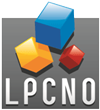Applications in nanomedecine and energy storage
Magnetic nanoparticles may be used for the destruction of cancer cells, when subjected to a high-frequency magnetic field, a phenomenon known as magnetic hyperthermia. During the past ten years, research on magnetic hyperthermia in our team was particularly rich in results, both theoretically and experimentally.
On the theoretical side, a major effort was made to develop rigorous models. We have developed numerical simulations and analytical expressions for calculating the heating powers of nanoparticles, which in turn allows to precisely define the general principles for optimization. Our work in this area are now main reference on this issue.
We have also developed several setups specifically dedicated to the study of hyperthermia, such as high frequency electromagnets and magnetometers (see Fig. 1 (a)). As part of a European project (Multifun), we have contributed to the development of new magnetic field applicators and distributed them to four partners of the consortium.

Furthermore, we have measured and analyzed the hyperthermia of different types of nanoparticles synthesized by the NCO group, in particular FeCo, Fe, FexC. One can note three main results: i) a comprehensive study combining theory and experiment on the size dependence of the heating power output of iron NPs (see Figs. 1b) and 1 (c)), ii) the measurements of FexC nanoparticles, which have the most important heating powers of the literature at low magnetic field. The basic mechanisms at the origin of these properties were comprehensively analyzed (competition between anisotropy and magnetic interactions),and iii) the experimental and theoretical demonstration that magnetic hyperthermia can not be done in an Magnetic Resonance Imaging setup.
We also started two years ago a collaboration with a group of biologists (EA 4552, D. Fourmy, Université Paul Sabatier, Toulouse) and obtained together results on the cell death by application of magnetic (see Fig. 1 (d)). In these experiments, no macroscopic heating was measured, which brings new questions about the mechanisms actually involved.
The work with NCO team on the synthesis of carbide iron particles led us to use their large heating power and their surface reactivity to achieve directly the Fischer Tropsch reaction by applying a alternating magnetic field. Nanoparticles then become both the heat source and the catalyst element. This led to the emergence of a new topic in the laboratory : catalysis by hyperthermia.
